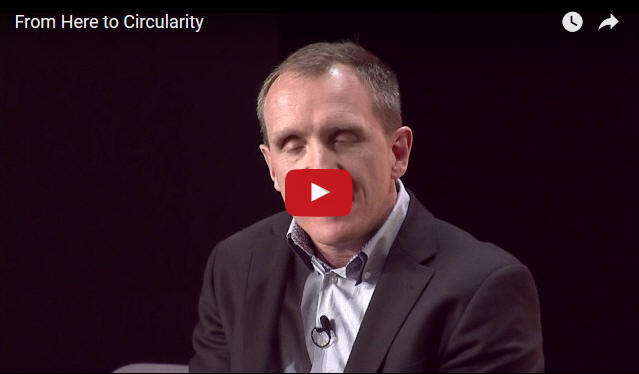
 |
| Reviews and Templates for Expression We |
Waste not, want not: 5 videos about scraping value from trash

The circular economy is one of the most intriguing concepts changing the business paradigm. Its aim is to eradicate waste inside companies and their supply chains, as well as within products and their transportation, using and reusing as many materials as possible. It's not about delaying the journey to landfill, but nixing it entirely.
Restorative and regenerative by design, the circular economy helps technology and manufacturing mimic the natural biological cycle, where nothing is truly wasted, and every used resource is useful for another creature (or product or organization).
But if companies cease buying raw materials, or invest large amounts of resources into "circular" processes, won't it slow the economy? Instead, as the following five GreenBiz videos show, corporations reducing waste or investing in circular products enjoy a boost in customer trust, organizational efficiency and cost savings. But they have to maintain this vision for the long haul.
1. Weaving together community and corporate, one thread at a time
Can the circular economy redefine how manufacturers outsource raw materials? Thread International transforms plastic trash from the world's poorest communities into material for brands with widespread impact. Thread has sourced plastic for responsibly made fabric used in Timberland shoes and bags and, recently, for HP's closed-loop ink cartridge program.
"I have an environmental company, but we actually care more about putting the 3,000 people to work in the supply chains that we work with," said Thread CEO Ian Rosenberger, describing the hazardous, unsupervised conditions in which landfill pickers often work in developing countries. Thread creates community jobs with dignity while addressing the waste issue and growing a business.
"To me, this is ground zero in the environmental crisis," Rosenberger said.
2. Amazon, sustainability and packaging
What is that iconic yellow Amazon logo smiling about?
At least one reason is its "frustration-free packaging," which ships goods in one container, is easy-to-open and sized to fit the product inside. Taking 90 seconds to unwrap and assemble the product within, compared to nine minutes for a traditionally wrapped box, eliminates what Kara Hurst, Amazon's director of worldwide sustainability and social responsibility, calls "wrap rage."
"Fundamentally, the experience around packaging is changing," she said.
Packaging siphons up to $3 trillion from the $22 trillion e-commerce industry, offering little value to customers. Repackaging the shipping box results in a better user experience while decreasing costs and reducing environmental impact.
3. Staples' Mark Buckley on tackling waste within e-commerce and shipping
Office giant Staples' e-commerce business is third only to Amazon's, but its waste reduction efforts are just as robust, tackling weighty issues such as secondary packaging for outbound freight and circular economy solutions.
"Excess packaging is the second-highest negative score that we get," said Buckley. To gain consumer trust and business efficiency, Staples has invested in right-sized packaging, developed a circular economy research partnership with the Rochester Institute of Technology and works with the Sustainable Innovation Lab to move waste materials back into production, such as using remanufactured ink and toner systems.
"It makes us more profitable, more efficient and reduces our impact on the environment," concluded Buckley.
4. From here to circularity
It's a long journey, especially for companies that are bending their supply chains circular, like at office furniture manufacturer Steelcase: Seven years in the making, its walk towards circularity is still beginning.
"Sustainability has been a good trip, but it's going to be more exciting from here," said Steelcase's director of global sustainability, Angela Nahikian.
In a long, nearly 20-minute-long video, Nahikian and Dan Dicks, Steelcase director of global end-of-use services, describe how they have carefully built relationships with influencers beyond the sustainability department to reach the destination together.
"We think about the circular economy a manifestation of our purpose," said Nahikian, but "we're not going to get it right on day one." Participate actively in product life cycles, even beyond their end-of-use point, promotes efficiency, innovation, waste reduction and cost savings.
5. Dow's Jeff Wooster on recovering plastic marine debris
Dow's view on the circular economy is as broad as its product options, according to Jeff Wooster, global sustainability director at Dow: It's "anything that we can do to improve resource efficiency, capture materials and put them back in the industrial system and create value out of things that had no value."
In order to be effective, though, Dow has narrowed its focus to combat marine plastic. Through a 30-year partnership with the Ocean Conservancy, the consumer goods company has become a researcher discovering the root of plastic debris in the ocean.
They found that developing economies, where income is growing but not waste management practices, tend to be the biggest sources of marine plastic debris.
Up to 90 percent of plastics, by weight, can be recycled, but there are challenges around keeping lightweight plastics, such as food wrappers, out of the waste stream.
"It takes a combination of private industry, the public sector, governments, local activist groups and civic organizations working together."
|
|
|
|
Copyright remains with the original authors |




